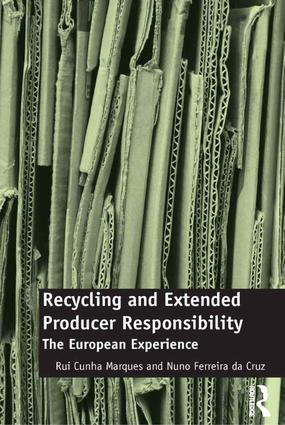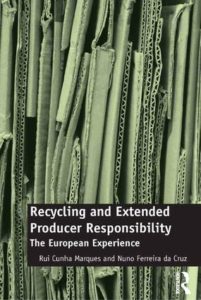
Recycling and Extended Producer Responsibility: The European Experience by Rui Cunha Marques & Nuno Ferreira da Cruz

Urbanization and modern consumption practices are contributing to a worldwide waste crisis. Estimates suggest that by 2025 the average person will generate nearly 1.5 kg of waste every day; the global equivalent of 2.2 billion tonnes of waste annually.[1] Waste has traditionally been managed in two ways: buried or burnt. These forms of waste management—although cost effective—have caused a myriad of environmental problems including polluting water, air, and soil; endangering wildlife and waterways; and contributing to climate change. Despite these issues, governance of waste remains a mysterious subject involving many actors in a complex and often opaque system, which has traditionally been largely ignored by academic research. For over twenty years, the European Union (EU) has sought to manage municipal waste through a suite of environmental legislation designed to limit the environmental consequences of waste.
For over twenty years, the European Union (EU) has sought to manage municipal waste through a suite of environmental legislation designed to limit the environmental consequences of waste.
Prompted by a series of Directives, EU member states have adopted numerous and varied strategies to reduce their municipal waste and to encourage recycling. Although performance varies across states, the EU’s overall recycling rate has improved significantly over the last two decades. Placing the onus upon producers to take responsibility for their product, not only beyond the factory gate but also as post-consumer waste, the Extended Producer Responsibility (EPR) Principle is a key pillar of the EU waste legislation. EPR regulations have been introduced within the EU to manage electronic (WEEE), vehicle, battery, and packaging waste, resulting in legal, economic and environmental impacts in each member state. Marques and da Cruz’s (2015) seek to explore some of these impacts in their new book ‘Recycling and Extended Producer Responsibility: The European Experience’
The book focuses exclusively on the European Waste Packaging and Packaging Waste (PPW) Directive (94/62/EC): an early but innovative initiative. The PPW Directive has two clear objectives: to minimize the impact of packaging and packaging waste on the environment and to harmonize national legislation on packaging waste within the European single market. To achieve these objectives the PPW Directive has set targets for member states in recycling and recovery of packaging waste. It also introduced requirements for the design and construction of packaging to encourage the minimization of packaging waste and the use of recycled materials in packaging. The PPW directive has been interpreted in a number of ways, but many states manage their obligations by charging companies a fee (the Green Dot fee) relative to the sorts and volumes of packaging waste their products create.
Drawing from research conducted as part of a three year project funded by the European Bank (“The Economic Impact of the Packaging and Packaging Waste Directive” or “EIMPack Project”) lead authors Marques and da Cruz are by a number of contributing researchers in a series of chapters that consider the implementation of PPW Directive in seven member states (France, Italy, Belgium, Germany, United Kingdom, Portugal, and Romania). Through these case studies, the book seeks first to understand how the PPW Directive objectives are “translated into practice” (p.xvii) and then, from the premise that “waste recovery is no an end in itself” (169), the book offers an economic analysis of the financial costs and environmental benefits of the PPW Directive in each country; to explore whether the initiative offers a value for money solution to reduce environmental harm in Europe.
The book is clearly divided in half, not only in terms of objectives but also content and contribution. The book begins by providing a background to the PPW Directive, defining the scope of the legislation and outlining the current European packaging waste landscape. From the description of the PPW Directive in Europe it is clear that although all member states are driven by similar recycling and recovery targets under the principle of EPR, emerging and differentiated institutional changes have resulted in a range of financial and legal instruments to implement the PPW Directive across member states. The bulk of the first section of the book is dedicated to identifying and explaining the legal and institutional frameworks, stakeholders, and compliance mechanisms in each of the seven chosen member states, where the complexity and diversity of approaches to implement the PPW become apparent.
The second part of the book offers a cost-benefit analysis of the PPW Directive in each of these member states. The analysis involves four steps: i)identification of the economic and financial costs for local authorities of sorting and collecting packaging waste; ii) a life cycle assessment of the environmental impacts of collecting and treating waste packaging; iii) an environmental valuation which ascribes monetary values to the identified impacts; and iv) comparison of all economic and environmental costs and benefits. Data was drawn from waste management operators’ annual reports and local authority questionnaires and was not available for all steps of analysis for every member state. The competitive nature of the UK and German schemes as well as the collection method employed in Romania (which does not separate industrial and municipal waste) meant that limited financial costs were available, rendering those states incomparable with the other case studies. In addition, the time-consuming data requirements for the environmental impact assessment and valuation meant that this analysis was only undertaken on three states (Belgium, Italy, and Portugal).
Unavailable data and complex analysis meant the book had to focus upon findings from just three of the member states: Portugal, Belgium, and France (with further analysis given of Italy’s Lombardia Region). Marques and da Cruz find in these three cases that, in an economic analysis, the benefits of the PPW initiative outweigh the costs, therefore they surmise that industry payments and environmental benefits more than cover local authority costs for packaging recycling (128 percent in Portugal; 135 percent in France and 204 percent in Belgium). They argue that, from an economic perspective, “local waste management fees or taxes did not have to increase so that selective collection and sorting could be carried out” (173). They acknowledge that from a financial perspective (where environmental benefits are not costed in the analysis) the situation is less clear cut, with industry support payments needing to increase (by 35 percent in Portugal, 121 percent in France and 11 percent in Belgium) to cover the current local authority costs in collecting and sorting packaging waste.
The book stops short on claiming which approach member states should take in evaluating their own strategies—arguing that this is a “policy decision” (174). Although the authors postulate that under the PPW directive a “strictly financial approach” should be applied, they question whether this would raise issues of inefficiency within local authority waste management (ibid). The authors also admit that their findings do not permit a full consideration of either the welfare costs (could the money spent on recycling be better spent elsewhere?) or benefits (has the new recycling infrastructure brought jobs and sub-markets?). They suggest that these questions could be raised by future studies and importantly acknowledge that such research should not rely on economic analysis alone. Recognizing the limitations of their own exploratory study, they acknowledge the many variables that affect PPW implementation in different member states including technology, environmental impacts, existing economic instruments (i.e. landfill taxes), and local cultural conditions that are often not best explored through economic analysis. They call instead for interdisciplinary studies which explore economic efficiency alongside ethical considerations and social-political elements (177). The importance of employing interdisciplinary methods to analyze the multidimensional elements of waste governance is well recognized in the literature.
The importance of employing interdisciplinary methods to analyze the multidimensional elements of waste governance is well recognized in the literature.
Waste governance is noted for its complexity,[2] which—despite using familiar narratives—can differ widely across different states[3]. The accounts given by Marque and da Cruz of PPW regulations in each case study supports this perspective. The work undertaken to uncover the PPW practices in each of the seven member states should not be underestimated. Waste governance is still a murky area marked by scant academic consideration: instead, knowledge of stakeholders, legislation and current practices usually resides within industry. The clear and concise account of the implementation of the PPW directive given in this book not only opens up discussion of the PPW directive in practice, but also shines a light on some of the differences and similarities in European waste governance more generally.
Moreover, the methodology adopted to consider the cost-benefits of EPR legislation could be extended beyond analysis of PPW and European states. The EU is noted for its established waste management infrastructure and regulations; many developing states still adopt ad hoc, market-driven approaches to governing waste, which lack government support. As western consumption patterns are emulated across the world, municipal waste is expected to increase. Marques and da Cruz’s methodology offers some potential as a framing through which states could evaluate a range of governance interventions.
Although the current methodology offers some potential value for policy-makers, the authors are clear that it is only an initial step in making sense of the economic costs of sustainable waste governance interventions. As a result, the contributions of the book are found less in the findings from the economic analysis, and rather in the recognition of the lack of data available to produce strong findings. Poor data is a well-established problem in waste research and policy evaluation; however, few studies clearly unpick the consequences of this lack of data on particular forms of analysis, nor that types of data that might make future studies more constructive. Marques and da Cruz offer this insight in the book, with much of the concluding chapter offering suggestions for future research, which would strengthen their own methodology and develop understandings of PPW. This is clear and useful academic contribution, if perhaps an unexpected by-product of their own research aims.
Without these more general contributions to research on waste governance, the conclusions of the book are tentative. The research aim is undoubtedly blighted by the lack available data, which meant full cost-benefit analysis was only undertaken on three of the seven case studies. However, even within this data some of the presumptions made (particularly about the replacement of virgin material in packaging) and the environmental benefits of recycling are potentially controversial. Under the guise of unavailable data, the study seems to ignore the persistent question that pervades public discourse of what happens to recycled materials within European states and they offer little evidence to show that the sorted material is recycled within the EU or used in new packaging.
From the outset the justification for choosing the seven member states also appears scant, with little attention paid to the socio-political dimensions of each member state. As the book progresses it becomes clear that the market-based approach of Germany and the UK packaging waste systems make them particularly unsuitable for the chosen cost-benefit methodology. Similarly, from a more practical perspective, the choice of Romania—which does not provide separate data for municipal, industrial and construction waste—seems ill-considered. These choices leave the reader questioning why the study has chosen to ignore other member states who may have more readily available or appropriate data (including the environmental champion Nordic states).
Admittedly the book does not offer a comparison of PPW governance in Europe; instead the authors aim to highlight “different approaches to cope with the same problem” (169) and comparative analysis of member states’ approaches is limited. This decision is understandable and avoids acknowledging the multifarious existing cultural and institutional structures, which shape waste governance within each state. Nevertheless, although the authors do little to facilitate more complex comparative analysis, the reader will inevitably make comparisons: for example between the apparent relative successes of Belgium versus Portugal in controlling packaging waste cost efficiently.
Marques and da Cruz note that no definitive conclusions can be drawn from a comparison that does not acknowledge the differences in technological infrastructure; environmental contexts; economic instruments; and local conditions (177). This raises the question of the value of their own analysis. Although an ambitious attempt to understand the PPW across Europe, their findings could have arguably been stronger with more attention paid to a richer comparison between two or three member states. Moreover although detailed analysis was only conducted upon three states and one region (a consequence of a combination of issues including data availability and governance complexity) the book does make some broader claims about European waste governance suggesting that “overall the PPW Directive has had a positive impact” in Europe (174).
The positive impact of the PPW Directive in Europe is clear, recycling rates are up and packaging waste production is decreasing. In exploring the ways in which each member state has implemented the Directive, Marques and da Cruz have shed light on important and potentially useful initiatives to tackle the global issue of municipal waste. Moreover their research has identified the need for both additional waste data and an interdisciplinary approach to analysis of that data. In providing an overview of area of public policy masked by murk, riddled with complexity and remarkably under-researched, Marques and da Cruz have provided an overview of, the PPW Directive in Europe which will hopefully encourage future studies to adopt more detailed comparisons, giving richer interdisciplinary accounts of waste governance in Europe.
Reviewed by Dr. Lucy J. Wishart, University of St. Andrews
Recycling and Extended Producer Responsibility: The European Experience
by Rui Cunha Marques & Nuno Ferreira da Cruz
Routledge
Hardcover / 220 pages / 2015
ISBN: 9781472450814
To read more book reviews, please click here.
References
[1] Hoorweg D, & Bhada-Tata, P. What a Waste: A Global Review of Solid Waste Management. World Bank: Washington DC March No15 Available Online: http://siteresources.worldbank.org/INTURBANDEVELOPMENT/Resources/336387-1334852610766/What_a_Waste2012_Final.pdf
[2] Bulkeley H, Watson M, Hudson R, & Weaver P, (2005) Governing municipal waste: towards a new analytical framework’ Journal of Environmental Politics and Policy Vol. 7 pp1 – 23
[3] Davies A.R, (2008) The Geographies of Garbage Governance: Interventions, Interactions and Outcomes. Ashgate: Aldershot
Published on December 1, 2016.




